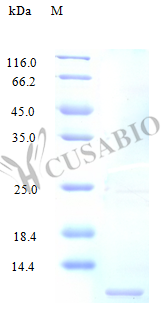Recombinant Human CX3CL1, also known as Fractalkine, is a multifunctional chemokine involved in immune responses and plays a critical role in the recruitment and activation of leukocytes[1]. Our recombinant human CX3CL1 is a partial protein, comprising amino acids 25-100, with a molecular weight of 8.6 kDa. Expressed in E. coli, this tag-free recombinant protein is available in liquid or lyophilized powder form, making it suitable for various research applications in the field of immunology.
Our Recombinant Human CX3CL1 features a purity greater than 97% as determined by SDS-PAGE and HPLC, ensuring high quality for your research needs. The endotoxin level is less than 1.0 EU/ug, as determined by the LAL method. The biological activity of our CX3CL1 has been verified by a chemotaxis bioassay using human T-lymphocytes, demonstrating activity within a concentration range of 5.0-10 ng/ml.
Studies have shown that CX3CL1 is implicated in a wide range of immune-mediated disorders, such as atherosclerosis, multiple sclerosis, rheumatoid arthritis, and inflammatory bowel disease[2]. Additionally, CX3CL1 has been linked to the regulation of tumor progression and metastasis in certain types of cancer[3].
References:
1. Bazan JF, et al. A new class of membrane-bound chemokine with a CX3C motif. Nature. 1997;385(6617): 640-4.
2. Jones BA, et al. Fractalkine/CX3CL1: A potential new target for inflammatory diseases. Mol Interv. 2010;10(5): 263-70.
3. Park MH, et al. Serum fractalkine levels are elevated in patients with advanced non-small cell lung cancer. Korean J Intern Med. 2010;25(2): 146-52.






